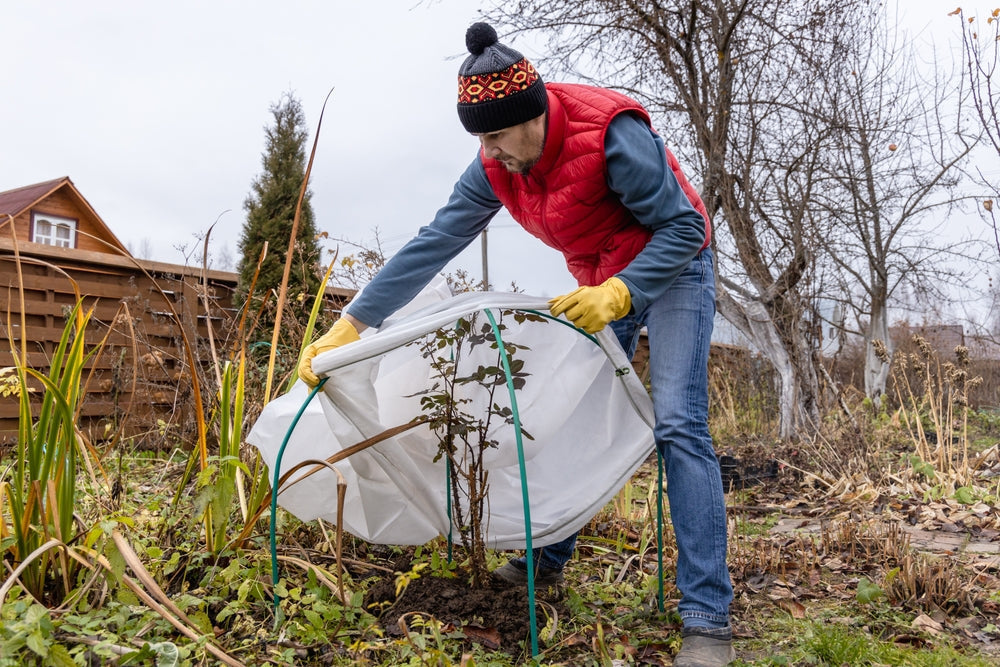Winter Protection For Fragile Garden Plants, Trees and Shrubs
As winter approaches and garden beds prepare to rest, it's essential to focus on protecting your plants. At TN Nursery, we understand that some plants are sensitive to cold nights, and we want to help you keep them safe so they come back strong in spring. Here are ten reliable ways to protect your delicate plants from freeze damage.
1. Choose weather-appropriate varieties
Choosing plants that match your climate zone is the best way to start. At TN Nursery, we offer a variety of hardy options that can withstand cold weather. Ensure you know your USDA zone and select plants that are suited to it. If a plant is less hardy, it will need extra protection.

2. Water well before a cold snap
Wet soil keeps heat better than dry soil. Water the root area the night before a freeze to help plants handle temperature changes. This works well for shrubs and evergreens. Avoid watering if the ground is already frozen, as this can harm the roots.

3. Apply a thick layer of mulch
Mulch works like a blanket, keeping soil temperatures steady and protecting plant crowns from frost. We suggest adding a 2-4 inch layer of straw or pine straw around plants that need extra care. For example, you can use long-leaf pine straw like this:

Long Leaf Pine Straw Mulch
Pennington Compressed Pine Straw
GardenStraw Premium Wheat Straw Mulch
Pine Bark Mulch 2‑cu‑ft
Long Leaf Pine Straw Bale
Premium Pine Straw Mulch Bag
Longleaf Pine Straw Roll
CleanStraw Natural Straw Mulch
Brief highlights:
- Long Leaf Pine Straw Mulch: high-coverage, iconic look, great insulation.
- Pennington Compressed Pine Straw: convenient bagged form, easy to handle.
- GardenStraw Premium Wheat Straw Mulch: lighter colour alternative, organic feel.And so on.
4. Cover plants on very cold nights
Some plants are more sensitive to cold, like potted plants, new transplants, or shrubs with thin bark. Covering them with frost cloth, burlap, or even a bed sheet can help.

Good For Protection:
Greenscape Frost Blankets
Agfabric Plant Cover Frost Protection
Planket Frost Cover Roll
Rose Cone Plant Protector
Wellco Winter Plant Cover Zipper
DeWitt Plant Frost Protection Cloth
Agfabric Shrink‑Wrap Plant Cover
Maximum Rose Cone Plant Protector
- Greenscape Frost Blanket: breathable spun-bond fabric, large coverage.
- Maximum Rose Cone Plant Protector: great for smaller shrubs like roses or delicate perennials. Be sure the cover does not touch the leaves. Use stakes to support it, and take the cover off in the morning to prevent overheating.
5. Create windbreaks for exposed plants
Cold wind accelerates heat loss, especially when it causes plants to lose heat more rapidly, such as evergreens or newly planted shrubs. You can wrap the side facing the wind with burlap or set up a temporary fence or screen.
This helps protect sensitive plants from too much cold. Heavy pruning late in the season, plants need as much foliage as possible to buffer against cold. If you do prune, do so in early fall when the risk of an extended freeze is lower. Dormant pruning (in mid-winter) is okay for many trees, but avoid cutting right before a deep freeze. TN Nursery
7. Move containers and potted plants indoors or to/more sheltered location.
Potted plants freeze faster because their roots are exposed to the cold air. For plants that dislike the cold, consider moving them into a garage, shed, or unheated sunroom. If that's not possible, lift the pots off the ground and wrap the rims with insulation.
8. Avoid fertilising late in the season
Fertilizing late in the season can cause new growth that is easily damaged by frost. When it gets cold, stop fertilizing and let your plants acclimate to the weather. Start fertilising again in early spring when new growth appears.
9. Ensure good drainage and reduce wet soil risks
Wet, heavy soil does not freeze evenly and can harm roots or cause frost heave. If your soil does not drain well, try raising the bed a bit or adding organic matter. Also, keep mulch away from the base of branches to prevent excessive moisture from accumulating.
10. Monitor weather alerts and react early
A sudden cold snap can do more damage than a slow freeze. Watch your local weather, and if a big chill is coming, use covers, water your plants, or set up windbreaks. As TN Nursery says, being prepared is half the battle.
Why this matters for your garden
In winter, your garden is not sleeping; it's just slowing down. Protecting your plants now helps them start the spring healthy, rather than damaged or delayed. At TN Nursery, we want to help you keep your landscape strong all year. A little preparation can prevent damage from settling in.
Most Asked Questions about Winter Garden Protection Tips
Q: When should I apply mulch for winter plant protection?
A: Apply mulch in late autumn once the soil is still workable but before deep freezes set in. It helps regulate soil temperature and protect roots.
Q: Can yellowing leaves on evergreens signal freeze damage?
A: Yes. Yellow or brown needles on evergreens in late winter often indicate cold stress or root damage. Proper winter insulation helps prevent that.
Q: Is it better to cover plants before or after a frost?
A: It's better to cover before the frost hits so the material can trap residual heat from the day. Covering after damage has started is less effective.
Q: Will mulch alone protect potted plants from freezing?
A: Mulch helps but pots lose heat quickly. Combine insulation around the pot, move to a sheltered area, and elevate off cold ground for best results.
Q: How do I know if a plant has recovered after freeze damage?
A: Wait until late winter or early spring when new growth should appear. If buds swell and green appear, recovery is likely. Prune away dead tissue once recovery evidence is clear.

